Koi Pond Garden
The Koi Pond Garden is a very relaxing place to feel the serenity of God’s creation all around you.
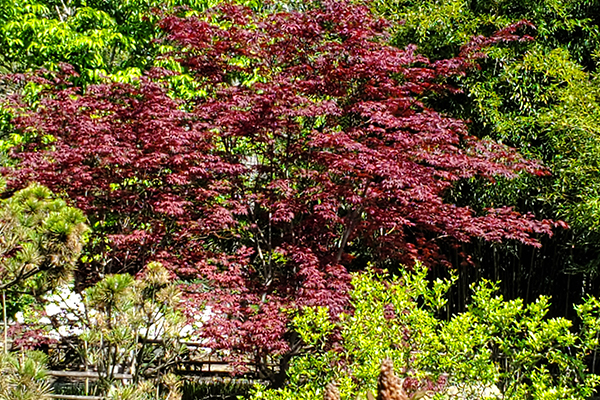
Bloodgood Japanese Maple
Common Name: Bloodgood Japanese Maple
Botanical Name: Acer palmatum
Height: 15–20 feet
Spread: 15–20 feet
Location: Full sun to part shade
Bloom: April, red
Hardiness zone 5–8
While the origins of the original cultivar of the Bloodgood is an ongoing dispute, there is no dispute that it is one of the most popular Japanese Maples. It is a large, red-leaved, upright-growing form that can be found in most local nurseries. They hold their deep red color later into the fall than some other varieties, and they are also known to have a better endurance of cold climates. They produce bright red samaras (helicopter seeds) in the fall, adding to the overall appeal of the plant. There are not many landscape designs that would not benefit by adding a Japanese Maple. Consider adding one in your garden too.
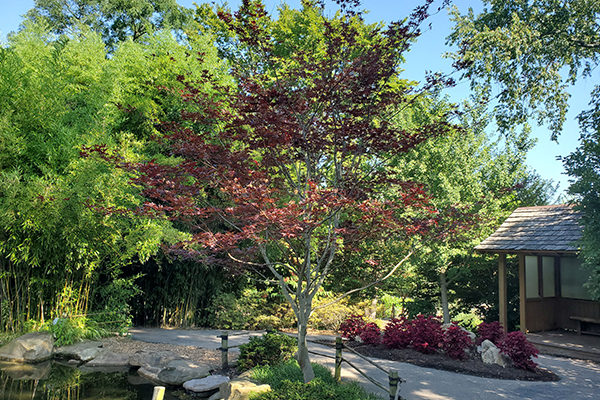
Emperor 1 Japanese Maple
Common Name: Emperor 1 Japanese Maple
Botanical Name: Acer palmatum
Height: 10–15 feet
Spread: 10–15 feet
Location: Full sun to part shade
Bloom: April, reddish-purple
Hardiness zone 5–8
Emperor 1 produces early season foliage that is reddish purple and is known to hold that leaf color better through the season than some other varieties. Another attribute is that the leaves emerge 2 weeks later than Bloodgood, making it less vulnerable to the damage that can be caused by the late spring season frost common at the Creation Museum. The reddish-purple leaves are thin textured and can look translucent in the sunlight throughout the growing season; then they change to more of a crimson color in the fall.
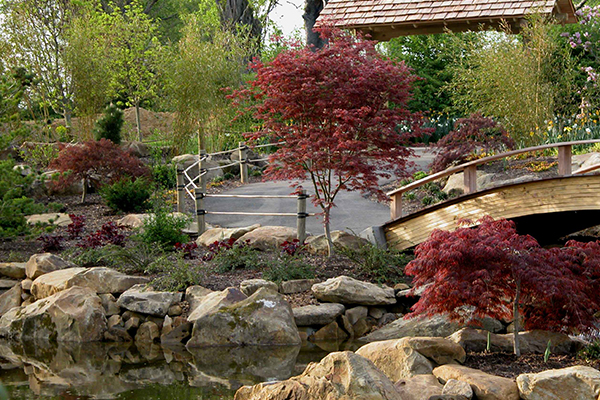
Chitose Yama Japanese Maple
Common Name: Chitose Yama Japanese Maple
Botanical Name: Acer palmatum
Height: 8–12 feet
Spread: 7–10 feet
Location: Full sun to part shade
Bloom: Early May, Olive with red, olive with pink, red, pink
Hardiness zone 5–9
This maple is named after the mountains near the town of Chitose located by one of the Japanese islands. The original clone originates from Japan in the late 1800s with a second clone (called the "Exbury Form") from England in 1990. Our Chitose is more characteristic of the second clone and has leaves that emerge in early spring a light green color with red on the tips. The leaves then turn more of an olive-green color in the summer season. It will normally produce an abundance of red flower blooms in the spring that hang like tassels covering the tree. This winner of the RHS Garden Merritt award turns a show-stopping bright red in the fall before dropping its leaves. Little if any pruning is required and should only be done in late fall or early spring if needed.

Tamuke yama Japanese Laceleaf Maple
Common Name: Tamuke yama Japanese Laceleaf Maple
Botanical Name: Acer palmatum var. dissectum atropurpureum
Height: 6–10 feet
Spread: 8–12 feet
Location: Full sun to part shade
Bloom: April, reddish-purple
Hardiness zone 5–8
Tamuke yama is an old cultivar of Japanese maple with records dating back to the early 1700s. The name means “tribute to the mountains,” and some records indicate plants living from 50 to 100 years old. The leaves are deeply cut and emerge a crimson red in the spring, changing to a darker, purple red that holds throughout the summer season. It grows in a mounded shape and spreads up to 12-feet wide with cascading and weeping branches. It will perform best with some wind protection and dappled sun in warmer climates.
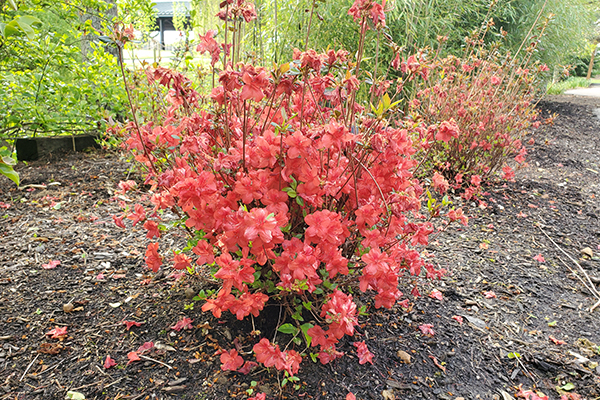
Stewartstonian Azalea
Common Name: Stewartstonian Azalea
Botanical Name: Azalea (Rhododendron)
Height: 4–5 feet
Spread: 4–5 feet
Location: Full sun to part shade
Bloom: April, red
Hardiness zone 5–8
This Azalea blooms a vibrant, orange red color in early spring and can add a punch of color to your garden. It is considered an evergreen with shiny green leaves through the summer, then it turns a darker red during the fall. Although evergreen, in a region with cold winters, some of the older leaves will shed and be replaced in the spring with new growth. Any pruning needed should be done after the plant is done flowering in the spring.

Hinoki Nana Gracilis False Cypress
Common Name: Hinoki Nana Gracilis False Cypress
Botanical Name: Chamaecyparis obtusa
Height: 3–6 feet
Spread: 2–4 feet
Location: Full sun to part shade
Bloom: non-flowering
Hardiness zone 4–8
A native of Japan, this plant is a slow-growing evergreen that is compact and grows only to 3 feet in the first 10 years. The “Nana” is appropriate in its name, meaning that this one is a dwarf variety. It has dark green foliage in artistic clusters that have silver hues on the undersides. Your garden would benefit from one of these as a specimen plant being both slender and graceful, also known as “Gracilis.”
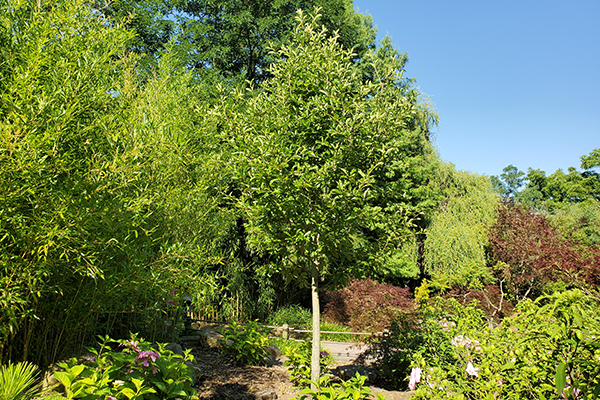
Perkins Pink Yellowwood
Common Name: Perkins Pink Yellowwood
Botanical Name: Cladrastis kentukea
Height: 30–50 feet
Spread: 30–50 feet
Location: Full sun
Bloom: May to June, pink
Hardiness zone 4–8
The Yellowwood is an underutilized Eastern US native tree that produces spectacular blossoms in the spring that cover the canopy with cascades of flowers that have the typical traits of wisteria flowers. The splendid blooms only occur every third year on a cyclical time frame and are usually 10 to 12 inches long. Yellowwood trees have smooth gray bark similar to the bark of a beech tree, and they have shiny green leaves that turn a bright yellow in the fall. This tree easily deserves a special place of prominence in most landscapes.
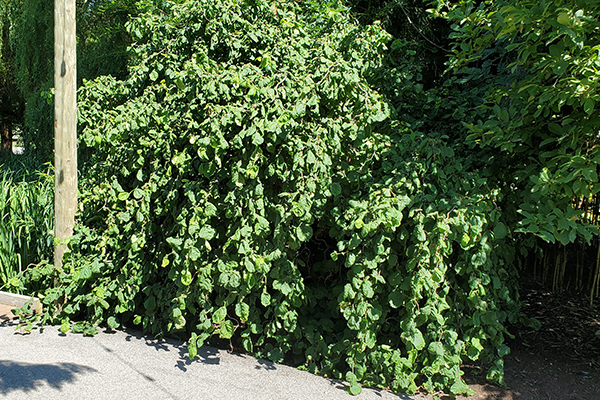
Harry Lauder's Walking Stick
Common Name: Harry Lauder's Walking Stick
Botanical Name: Corylus avellana contorta
Height: 8–10 feet
Spread: 8–10 feet
Location: Full sun to part shade
Bloom: March – April, greenish yellow catkins
Hardiness zone 4–8
The unusual growth habit of this plant attracts a lot of attention. We like to mention the contorted branches which help guests remember the botanical name. There is a lot of winter interest, so keep that in mind when you decide on a planting location in your landscape. This plant could easily be used as a feature plant or focal point, and it could also be used as a natural hedgerow, giving separation and privacy.
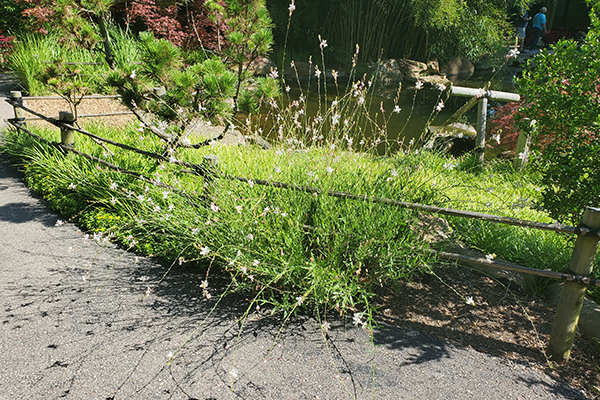
Whirling Butterflies
Common Name: Whirling Butterflies
Botanical Name: Gaura lindheimeri
Height: 2–3 feet
Spread: 2–3 feet
Location: Full sun
Bloom: May to September, white
Hardiness zone 5–9
Whirling Butterflies refers to the 4-petaled flowers that move around in the wind like butterflies. The long 2- to 3-foot-tall red plant stems have pink flower buds that slowly open a few at a time to a snow-white flower. They have a long season and will produce flowers from early summer to late fall. This is a North American wildflower that grows in a clump form but still adds an open-branching, almost wiry character to any garden. This variety is sterile, so it will not self-seed like some other varieties.

Maidenhair Ginkgo Tree
Common Name: Maidenhair Ginkgo Tree
Botanical Name: Ginko biloba
Height: 50–80 feet
Spread: 30–40 feet
Location: Full sun
Bloom: April, green
Hardiness zone 5–9
Some call this a “fossil tree” or a living dinosaur believed to be one of the oldest surviving plant families. Ginkgo is dioecious, meaning that there are separate male and female plants. The female variety are no longer in commerce due to the repugnant scent of their “fruit-resembling” seed ball, and all unidentified seedlings should be avoided. The fan-shaped leaf adds to the attractive characteristics of this shade tree which puts on quite a show in the fall when the leaves turn a remarkable yellow.
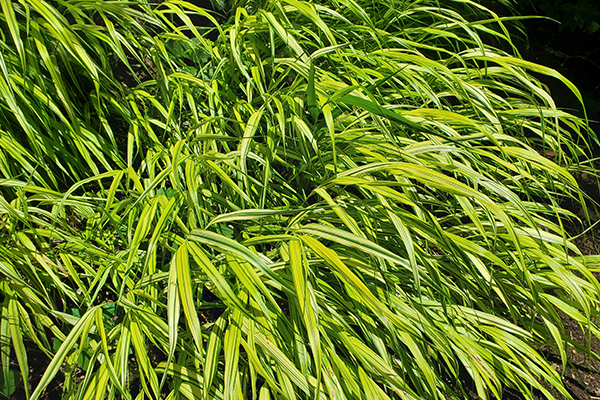
Aureola Japanese Forest Grass
Common Name: Aureola Japanese Forest Grass
Botanical Name: Hakonechloa macra
Height: 1–1.5 feet
Spread: 1–1.5 feet
Location: Part shade
Bloom: July to August, yellow green
Hardiness zone 4–9
This yellow-green variegated perennial grass grows in graceful, arching clumps that spread via rhizomes, although slowly. Natively, this is found in moist mountain or woodland areas around Mt. Hakone which is where the name comes from. Aureola is noted to be more winter hardy and a little better in full sun exposure than other varieties although it will perform better in part shade. It can take some time to establish but adds a beautiful texture to any garden.
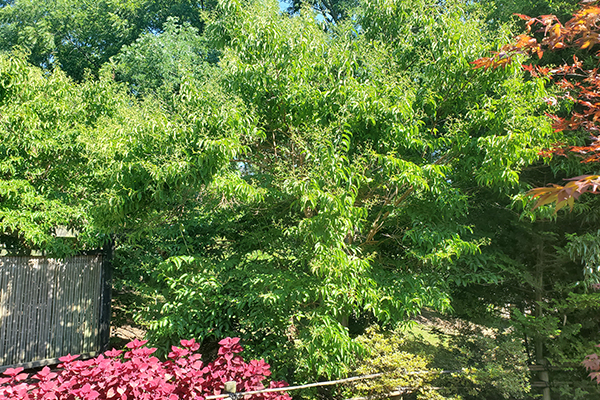
Seven Sons Flower
Common Name: Seven Sons Flower
Botanical Name: Heptacodium miconioides
Height: 15–30 feet
Spread: 8–15 feet
Location: Full sun
Bloom: September, white
Hardiness zone 5–9
The leaves of Seven Son Flower emerge a yellow-green color in the spring and then turn dark green for the summer. The leaves finish changing in the fall, turning degrees of yellow before dropping for the winter. This is normally a multi-stem plant, although it could be trained to be a single stem if you prefer. A noteworthy characteristic is the strips of peeling bark that will give appeal all year long to any garden. This is a very late bloomer not producing white flowers until September, adding a source of late season nectar for butterflies and hummingbirds. The pink-purple fruit that emerges after the flowers are done is believed to be the most attractive feature by some, although it is difficult to pick only one favorite with this plant.
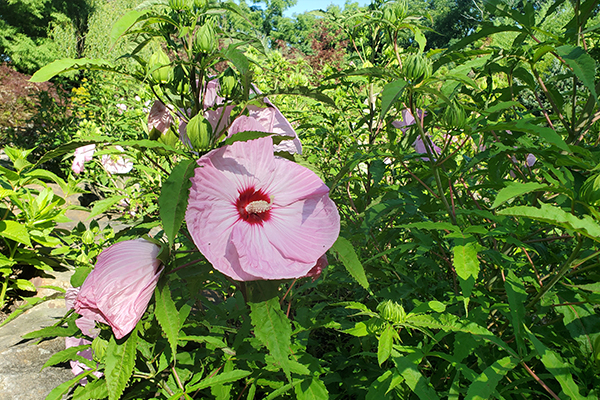
Party Favor Hibiscus
Common Name: Party Favor Hibiscus
Botanical Name: Hibiscus moscheutos
Height: 3–5 feet
Spread: 2–4 feet
Location: Full sun
Bloom: July to September, pink and white flower with red center
Hardiness zone 4–9
Visually, this is a high impact perennial plant with its plate-sized flowers and beautiful colors. When they are in full bloom, most guests are drawn to the flowers. They are easy to grow but do require more than average amount of water to keep the soil from drying out. We cut ours all the way back annually, and they come back bigger and better each year.
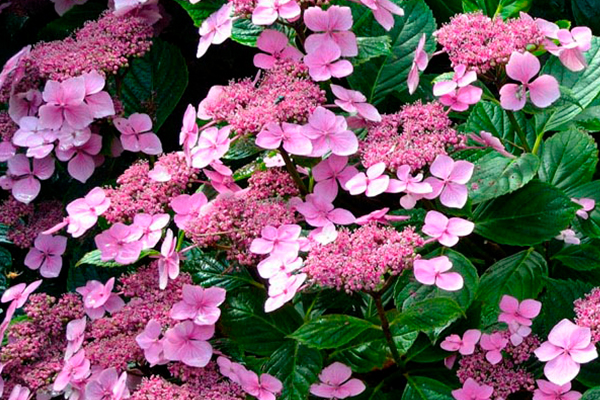
Twist-n-Shout Hydrangea
Common Name: Twist-n-Shout Hydrangea
Botanical Name: Hydrangea macrophylla
Height: 3–5 feet
Spread: 3–4 feet
Location: Full sun to part shade
Bloom: All summer, pink blue
Hardiness zone 4–9
In the “big leaf” variety of Hydrangea, there are two different forms of flowers, mophead and lacecap. The Twist-n-Shout flowers are the lacecap variety and are the first of its type to re-bloom through the season. The blooms range in color from a dark pink to a periwinkle blue depending on the soil conditions. Its plant stems are also unique because they are a vivid red, which adds more contrast and interest. You can use this plant as an individual planting or in a grouping as we have in the Koi Pond garden.

Big Blue Lilyturf
Common Name: Big Blue Lilyturf
Botanical Name: Liriope muscari
Height: 1–2 feet
Spread: .75–2 feet
Location: Full sun to part shade
Bloom: August to September, lavender
Hardiness zone 5–11
Big Blue Lilyturf is an easy-to-grow ground cover with grass-like, dark, glossy green leaves. It grows in clumps but also spreads unlike the variegated variety that stays in a clump. Showy violet-purple flower spikes are produced in late summer and stand above the foliage. After the flowers are done, dark blackish-colored berries appear and persist late into the year.
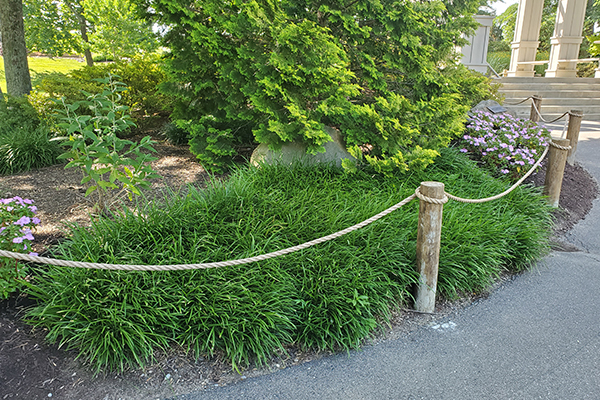
Creeping Lilyturf
Common Name: Creeping Lilyturf
Botanical Name: Liriope spicata
Height: .75–1.5 feet
Spread: 1–2 feet
Location: Full sun to part shade
Bloom: August to September
Hardiness zone 4–11
This variety of Liriope is used as a grass alternative in some regions, but most commonly, it is used as a perennial ground cover as we have in the Koi Pond garden. It spreads or creeps via rhizomes, which are a different root system than that of other liriope. It has glossy, thin leaves only a quarter-inch wide that normally hold their color through the winter until spring when they are cut back. It produces purple flower spikes that are followed by blackish berries in the fall. No serious disease or insect problems and very easy to grow.
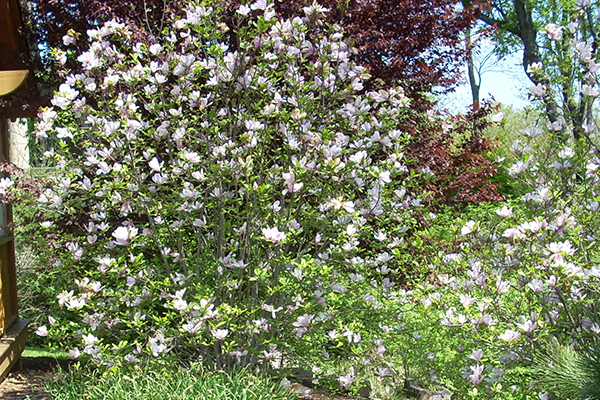
Jane Magnolia
Common Name: Jane Magnolia
Botanical Name: Magnolia
Height: 10–25 feet
Spread: 8–20 feet
Location: Full sun to part shade
Bloom: April to May, pinkish purple-white center flower
Hardiness zone 4–8
Jane is part of the little girl series of hybrid magnolias and normally grows to about 15-feet tall. They flower a little later in the spring than some other magnolias, reducing the risk of late-frost damage. The oval-shaped, green leaves emerge after the flowers and turn from dark green to yellow bronze in the fall. Very little care is required, and it is disease and insect resistant.
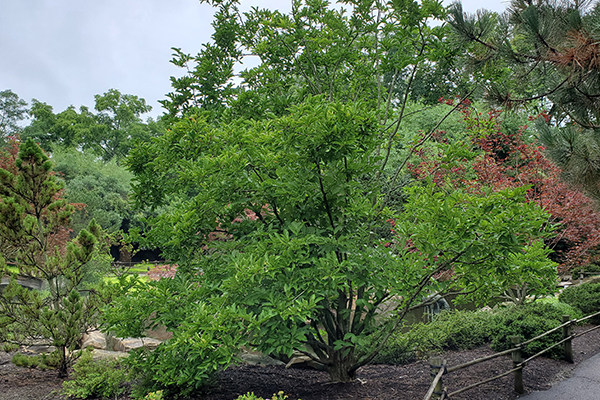
Leonard Messel Magnolia
Common Name: Leonard Messel Magnolia
Botanical Name: Magnolia loebneri
Height: 10–15 feet
Spread: 10–18 feet
Location: Full sun to part shade
Bloom: March to April, white to purplish pink
Hardiness zone 4–9
This hybrid magnolia is most often grown as a multi-stem plant rather than a single-trunk tree. The flowers appear in early spring before the oval-shaped leaves and are white in the center with a purplish-pink covering. They are hardier and less susceptible to frost damage than most other magnolias, making them a good choice for any area that receives occasional late-spring frost as we do at the Creation Museum. There are no serious pest or disease problems, and pruning is not normally required other than to remove any damaged or unwanted branches.

Yellow Groove Bamboo
Common Name: Yellow Groove Bamboos
Botanical Name: Phyllostachys aureosulcata
Height: 12–40 feet
Spread: 12–25 feet or more if not controlled
Location: Full sun
Bloom: rarely flowers
Hardiness zone 4–10
As an ornamental, Yellow Grove is one of the most widely planted varieties of bamboos introduced into the U.S. in the early 1900s. It is cold, hardy, and almost an evergreen with dark green culms and a yellow groove (sulcis) growing vertically on the side, making it very identifiable. The leaves are also dark olive green and grow to 7-inches long. This is a great plant to use as a screen, hedge, or background for your garden. It spreads by rhizomes and will spread into unwanted areas unless a barrier is used as a control method.
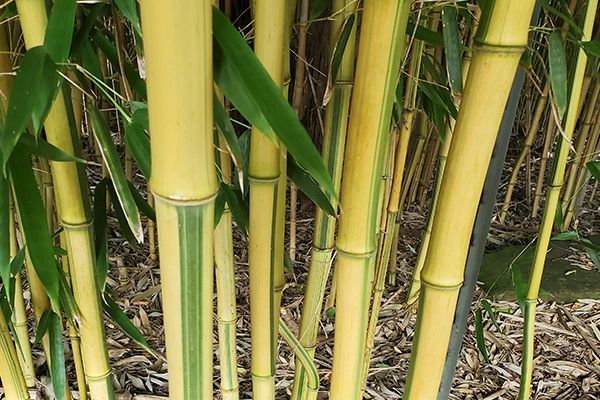
Green Groove Bamboo
Common Name: Green Groove Bamboo
Botanical Name: Phyllostachys aureosulcata spectabilis
Height: 15–30 feet
Spread: 12–25 feet or more if not controlled
Location: Full sun
Bloom: rarely flowers
Hardiness zone 5–11
This is a very cold, hardy variety of yellow bamboo considered by some to be the hardiest of all the yellow varieties. The yellow culm with a green stripe (sulcis) growing vertically up the side is spectacular. The leaves are dark olive green and grow to 7-inches long. This is a great plant to use as a screen, hedge, or background for your garden. It spreads by rhizomes and will spread into unwanted areas unless a barrier is used as a control method.

Tanyosho Pine
Common Name: Tanyosho Pine
Botanical Name: Pinus densiflora umbraculifera
Height: 10–12 feet
Spread: 15–20 feet
Location: Full sun
Bloom: non-flowering
Hardiness zone 3–9
This is an upright, slow-growing evergreen pine that has an umbrella-shaped crown, as the botanical name suggests. The orange bark becomes a superb characteristic as they mature, and some lower branches become more visible, like ours in the Butterfly and Hummingbird Garden. Although they are known to grow slowly and are considered a dwarf, they mature to 20-feet tall with an even wider top. Keep this in mind when selecting a location in your garden.
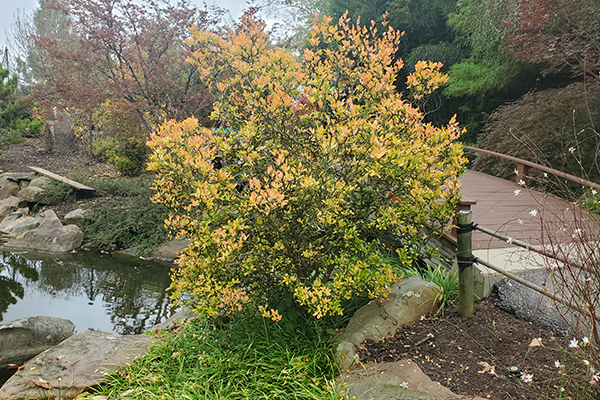
Flying Dragon Hardy Orange
Common Name: Flying Dragon Hardy Orange
Botanical Name: Poncirus trifoliata
Height: 3–8 feet
Spread: 3–6 feet
Location: Full sun
Bloom: April to May, white
Hardiness zone 5–9
Flying Dragon is an ornamental hardy orange tree that produces very acidic, edible fruit that could be used to replace a lime. Most gardeners plant this as a specimen or novelty plant admired for its unusual growth characteristics. The dark green stems are twisted, and the 2-inch-long, sharp thorns also have a slight twist. The leaves emerge a yellowish green in the spring, which turn a dark, glossy green for the summer. White flowers appear in spring, and the yellow-orange fruit follows in the autumn season. If the cold temperatures arrive early, the fruit may not be on the plant long enough to ripen at the Creation Museum.

Cutleaf Staghorn Sumac
Common Name: Cutleaf Staghorn Sumac
Botanical Name: Rhus typhina laciniata
Height: 9–18 feet
Spread: 15–20 feet
Location: Full sun to part shade
Bloom: July, greenish yellow
Hardiness zone 3–8
Cutleaf Staghorn Sumac is appropriately named with large, compound, deeply dissected leaves that have the appearance of a fern leaf and velvet-covered branching that looks like the horns of a male deer or stag. Tiny greenish flowers bloom in late spring, followed by autumn flowers that are shaped like bright red pyramidal cones that grab the attention. In the fall season, the leaf color ranges from yellow to orange to red, adding a colorful display to your garden.

Twisty Baby Black Locust
Common Name: Twisty Baby Black Locust
Botanical Name: Robinia pseudoacacia
Height: 8–20 feet
Spread: 12–15 feet
Location: Full sun to part shade
Bloom: rarely flowers
Hardiness zone 3–5
Twisty Baby is an ornamental black locust admired for its twisted shoots and unusual foliage. It is grown as a multi-stem shrub or as a single-trunk tree, like the one located in the Koi pond area of the Botanical Gardens. The dark green leaves turn yellow in the fall before dropping to expose the twist of the branches. This may be a good choice for your garden because it takes a smaller spot to grow and gives an abundance of winter interest.
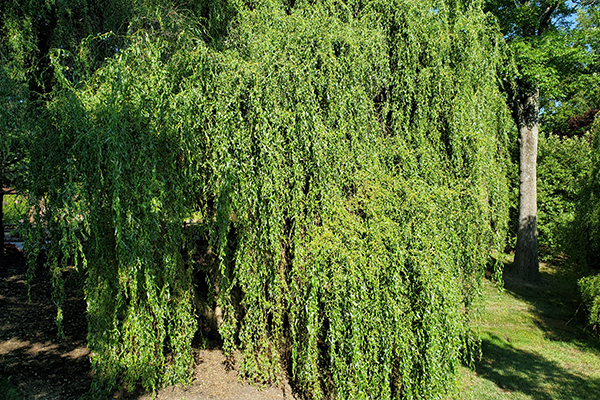
Scarlet Curls Corkscrew Willow
Common Name: Scarlet Curls Corkscrew Willow
Botanical Name: Salix matsudana alba
Height: 40–50 feet
Spread: 20–25 feet
Location: Full sun
Bloom: Early spring, yellow-green catkins
Hardiness zone 5–8
It can be hard to believe that the willow trees you see in our Koi Pond Garden started in 3-gallon pots planted in 2006. These are vigorous growers that give an abundance of appeal with their twisted growth habits. They do sucker and send off shoots at the base that require pruning on a semi-seasonal basis. They can be planted in groves as we have in our Bog Garden or as a single specimen in your garden.

Nutans Pondcypress
Common Name: Nutans Pondcypress
Botanical Name: Taxodium distichum var. imbricarium
Height: 30–70 feet
Spread: 15–20 feet
Location: Full sun
Bloom: non-flowering
Hardiness zone 4–9
Nutans Pondcypress is a deciduous conifer that grows best in an environment with plenty of available water, as the name suggest. It has horizontal branching and foliage that is somewhat pendulous and fern-like. It grows in a more upright and narrow form than its relative, the Bald Cypress, that we have around the Lake garden. The foliage turns a rust-orange in the fall before dropping for the winter.